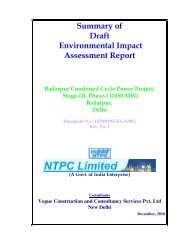EIA Studies of 3 Pre-Identified Hazardous Waste Disposal Sites in ...
EIA Studies of 3 Pre-Identified Hazardous Waste Disposal Sites in ...
EIA Studies of 3 Pre-Identified Hazardous Waste Disposal Sites in ...
You also want an ePaper? Increase the reach of your titles
YUMPU automatically turns print PDFs into web optimized ePapers that Google loves.
Rapid <strong>EIA</strong> <strong>Studies</strong> <strong>of</strong> 3 <strong>Pre</strong>-identified <strong>Hazardous</strong> <strong>Waste</strong> <strong>Disposal</strong> <strong>Sites</strong> <strong>in</strong> NCT - Delhi:<br />
Page No.80<br />
This site lies at the <strong>in</strong>tersection <strong>of</strong> the Kanjhawla block and the Alipur block. Mapp<strong>in</strong>g<br />
unit shown <strong>in</strong> Fig 4.21 is 22. The depth to bed rock is more than 300 m.<br />
The soils here are the soils <strong>of</strong> the older alluvial pla<strong>in</strong>s known to be deep, well<br />
dra<strong>in</strong>ed, coarse-loamy soils on very gentle slopes with loamy sand surface and slight<br />
erosion associated with deep well dra<strong>in</strong>ed f<strong>in</strong>e loamy soils with loamy surface, slight<br />
erosion and slight sal<strong>in</strong>ity.<br />
These soils belong to the Nabha –Ghoga series. This series <strong>in</strong>cludes f<strong>in</strong>e loamy and<br />
clayey soil, and is a member <strong>of</strong> mixed hyperthermic family <strong>of</strong> Udic Ustochrepts. The<br />
clay percentage ranges from 16-38% with maximum over a depth <strong>of</strong> 69-100cm depth<br />
bgl.<br />
Soil characteristics <strong>of</strong> Site II<br />
The site lies <strong>in</strong> the city block <strong>of</strong> the Delhi territory. Therefore the natural soil<br />
characteristics have been degraded due to urban development and <strong>in</strong>dustrialisation.<br />
It falls under miscellaneous category called quaternary alluvium.<br />
Soil characteristics <strong>of</strong> Site III<br />
This site lies <strong>in</strong> the Najafgarh block. Mapp<strong>in</strong>g unit as shown <strong>in</strong> Fig 4.21 is 21. The<br />
soils found here are also the soils <strong>of</strong> the older alluvial pla<strong>in</strong>s known to be deep, well<br />
dra<strong>in</strong>ed, coarse -loamy soils on nearly level slopes with loamy surface associated<br />
with deep well dra<strong>in</strong>ed, f<strong>in</strong>e loamy soils with loamy surface and slight sal<strong>in</strong>ity.<br />
The soil is <strong>of</strong> the Daryapur -Hamidpur series. The colour <strong>of</strong> the soil is yellowish.<br />
These soils are well-dra<strong>in</strong>ed with rapid permeability.<br />
Site IV: Bawana Old site:<br />
The soil at this site is <strong>of</strong> Khampur-Hissar series. Mapp<strong>in</strong>g unit as seen from Fig 4.21<br />
is 21. The soil <strong>of</strong> this association occurs on old flood pla<strong>in</strong>s on 1-3% slopes.<br />
Khampur series is silty clay loam to clayey and the Hissar series is silty loam to sity<br />
clay loam <strong>in</strong> texture. The soil <strong>of</strong> this site is extremely sal<strong>in</strong>e with white patches <strong>of</strong> salt<br />
layer visible on the surface <strong>of</strong> the land. The soil <strong>of</strong> this site has been classified as<br />
lands with problems <strong>of</strong> sal<strong>in</strong>ity and also water logg<strong>in</strong>g by NBSS & LUP.<br />
At this site there are pockets <strong>of</strong> coarse loamy and f<strong>in</strong>e loamy soils (8 to 10%). Large<br />
chunks <strong>of</strong> barren landscapes with white and brownish surface <strong>in</strong>crustation are<br />
common. They are uncultivated lands with pockets <strong>of</strong> salt resistant bushes <strong>of</strong><br />
Halozylon SPP. The electrical conductivity (total soluble salts) <strong>of</strong> surface soils are<br />
higher than 12 µmhos/cm which gradually decreases with depth.<br />
Fig 4.22 shows the extent <strong>of</strong> dra<strong>in</strong>age <strong>in</strong> NCT- Delhi. Well dra<strong>in</strong>age <strong>in</strong>dicates the soil<br />
is most suitable for agriculture from the po<strong>in</strong>t <strong>of</strong> view <strong>of</strong> irrigation. Site I & Site IV falls<br />
under zone moderately dra<strong>in</strong>ed whereas site III falls under zone well dra<strong>in</strong>ed. Site II<br />
falls under urban area.<br />
Environment Division, National Productivity Council, New Delhi<br />
4
















